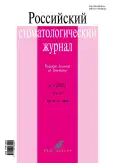Method of tooth restoration and reinforcement with significant destruction of the tooth crown
- Authors: Vorobieva Y.B.1, Zheleznyak V.A.1, Shchennikova M.N.1, Poplaukhin T.S.1
-
Affiliations:
- Kirov Military Medical Academy
- Issue: Vol 27, No 4 (2023)
- Pages: 271-279
- Section: Experimental and Theoretical Investigation
- URL: https://journals.rcsi.science/1728-2802/article/view/253504
- DOI: https://doi.org/10.17816/dent296333
- ID: 253504
Cite item
Abstract
BACKGROUND: One way to improve the quality of crown restoration of the tooth is to include a reinforcing component that increases the strength and durability of the restoration.
OBJECTIVE: To propose a new method for restoring extensive defects in hard tissues of teeth with additional reinforcement.
MATERIALS AND METHODS: During the work, 40 chewing anatomical and functional teeth were removed based on various criteria. Carious teeth cavities after removal were prepared for class 1 G.V. Blаck cavities. The wall thickness was measured using a dental micrometer; half of the teeth (20) had a wall thickness more than 3 mm, and half (20) had a wall thickness less than 3 mm. It was calculated how the load would be distributed in the tooth. Based on this, the optimal installation method for threads with composite in the tooth cavity was determined. We used dental adhesive Single Bond Universal in separate packages, dental composite material 3M ESPE Filtek Ultimate Universal Restorative, thread with composite material (light-curing dental fiber formed CATERPILLAR). Furthermore, we used a dental micrometer, laboratory electrical equipment, such as testing machine, hardness tester, Shimadzu trademark, and LEDEX dental light-curing lamp, model WL-070, Carl Zeiss Primo Star laboratory microscope, and emission scanning electron microscope Merlin (Zeiss) during the experiment.
CONCLUSION: The “Method of restoration of molars in case of significant destruction of the tooth crown” has been developed (RF Patent No. 2783060). It is presented as a method of restoring extensive defects in the crown part of the tooth with the use of composite tape as a reinforcing component. When the results of the study on the Shimadzu bursting machine were analyzed, it was revealed that restorations performed using a composite thread are more durable and, accordingly, more durable than similar therapeutic restorations of the shape and function of the tooth performed without the use of a composite thread.
RESULTS: In a laboratory test for maximum compression and stress, teeth restored with floss and composite material showed significantly greater resistance than teeth restored with composite material alone.
Full Text
##article.viewOnOriginalSite##About the authors
Yulia B. Vorobieva
Kirov Military Medical Academy
Email: doctor32@bk.ru
ORCID iD: 0000-0003-0394-7868
md, cand. sci. (med.), assistant professor Russian Federation, 194044, St. Petersburg, st. Academician Lebedev, 6
Vladimir A. Zheleznyak
Kirov Military Medical Academy
Email: zhva73@yandex.ru
ORCID iD: 0000-0002-6597-4450
md, cand. sci. (med.), assistant professor, head of the department
Russian Federation, 194044, St. Petersburg, st. Academician Lebedev, 6Marina N. Shchennikova
Kirov Military Medical Academy
Email: marina_75.08@mail.ru
ORCID iD: 0000-0003-4805-2304
lecturer
Russian Federation, 194044, St. Petersburg, st. Academician Lebedev, 6Taras S. Poplaukhin
Kirov Military Medical Academy
Author for correspondence.
Email: taraspoplau@gmail.com
ORCID iD: 0000-0001-9117-5874
lecturer
Russian Federation, 194044, St. Petersburg, st. Academician Lebedev, 6References
- Gaivoronsky IV, Petrova TB. Anatomiya zubov cheloveka. Saint Petersburg: Elbi-SPb; 2017. (In Russ).
- Adilkhanyan VA. Osobennosti vosstanovleniya zubov posle endodonticheskogo lecheniya [dissertation]. Moscow; 2003. (In Russ).
- Krutov VA. Effektivnost’ ispol’zovaniya elastichnykh shtiftov i kompozitnykh materialov dlya rekonstruktsii razrushennykh zubov posle endodonticheskogo lecheniya [dissertation abstract]. Saint Petersburg; 2013. (In Russ).
- Korenevskaya NA. Postendodonticheskaya restavratsiya v stomatologii. Vitebsk: VSMU; 2018. (In Russ).
- Iordanishvili AK, Kovalevsky AM, editors. Fakul’tetskaya stomatologiya. Moscow: SIMK; 2015. (In Russ).
- Vishnyakov NI, Danilov NO, Prozorova NV. Study of caries morbidity in accordance with appealability of population for dental medical care. Vestnik of Saint Petersburg University. Medicine. 2007;(4):133–142. (In Russ).
- Nikolaenko SA. Sovremennye aspekty restavratsii tverdykh tkanei zubov. Saint Petersburg: MEDI; 2007. (In Russ).
- Popova EA, Furtsev TV. Study strength of adhesive joints composite material and dentine depending on the type processing tooth cavity. Russian Journal of Dentistry. 2016;20(2):63–65. (In Russ). doi: 10.18821/1728-28022016;20(2)63-65
- Patent RUS № 2479278 C2/ 20.04.13. Kukushkin VL, Kukushkina EA, Nikulina VJu. Method for dental crown restoration. (In Russ).
- Patent RUS № 2783060/ 08.11.22. Vorobeva YuB, Zheleznyak VA, Gabaraeva ASh. Method for restoration of molar restorations in case of crown part of tooth destruction. (In Russ).
Supplementary files




















